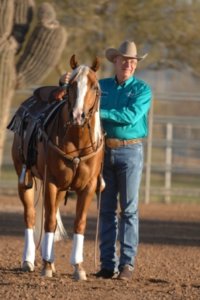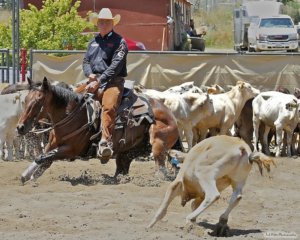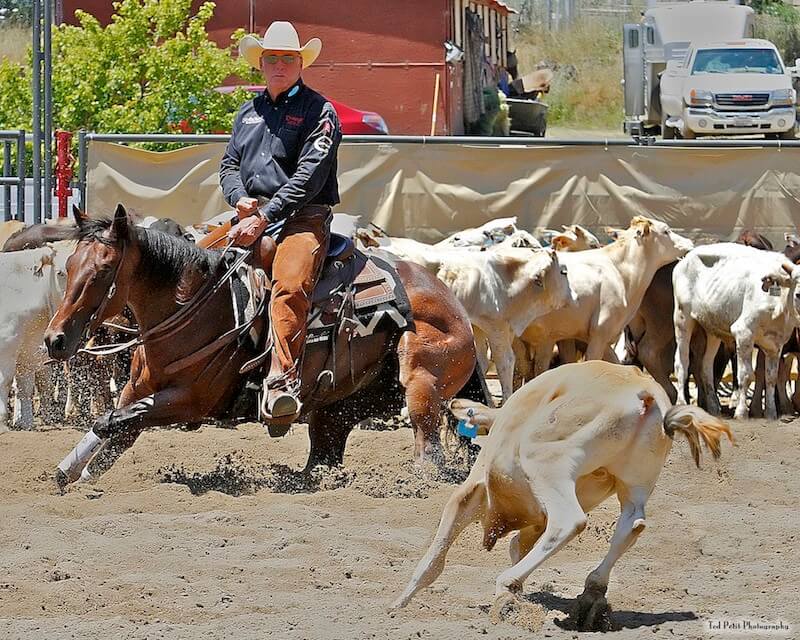Getting to the “Root” of a Problem and the Importance of Collection

Hi Al,
I have a horse that is pretty far along in reining disciplines. I’m riding him in a Myler bit with a small port which works very well. My problem is that when he canters for awhile, he tends to lower his head to the left and root on the bit. It’s almost like a tic. I’ve worked both reins, warmed the bit, worked one rein, but I cannot completely stop him unless I take hold of him and break him at the poll. He only does it at the lope, no other gait, and only after a distance over 100 yards on a loose rein. He never does it doing circles, stops or any other exercises. What should I do?
Reuben
Midland, TX
Hi Reuben,
Your horse’s rooting problem can be for a number of reasons. After you lope for extended periods of time without keeping a horse collected, anything can happen: he may be bored; he might need to be secured with a give-and-take rein to stay in frame; he might have bad teeth. If the bit you are using truly works properly and you have concentrated on softness, flexion, and collection, this should be easy to correct. It sounds like arena work with two hands, checking your fundamentals, would be beneficial.
Al
After training horses for over 40 years, I am firmly convinced that proper collection completely changes the dynamics of your horse’s performance. I’ll explain this fundamental aspect of training your horse by answering three key questions:
1)Why is it necessary? Some horses are built to have an automatic physical advantage when it comes to collection. Their conformation lends itself to being more compact and flexible. Their legs are up under them, they move well, and they have a sense of self-collection. Other horses are loose movers, strung out, and feel like their front feet are forward and clumsy and their rear legs lack power. Either horse must be well broke to respond to a rider’s legs and reins to perform any requested task. The goal of collection is to aid a horse in the ability to understand and more easily be maneuvered by his rider.

2)What does it do? When a horse achieves proper collection, they are round, soft, and in tune with the rider. Because their body is more balanced, stable and compact, they move and respond readily to cues. They will turn better as the turning radius is shorter. They will stop better because the head maintains form while the rear end rounds and drives into the ground. Balance is a big aspect of collection. Once you have the chin pulled to the rear and the rear pushed to the head, your horse’s stride is more up and down rather than forward. Proper collection equals control.
3)How do I achieve it? This is not an easy task. We concentrate on collection from the early stages of training. Lateral flexion is the precursor to vertical flexion. When we break colts, we bend them with the purpose of inhibiting forward movement and teaching them to “give” to pressure. We give and take to direct, then reward a correct response. During bending, use your inside leg to create roundness and give. Rather than a straight pull, I use offset rein pressure, usually picking up one rein and pulling with the other. I have developed a technique of jiggling my hands to ask for a reaction prior to the pull. A constant hold is used sometimes to steady the horse and I wait for a soft response before releasing.
The most important factor in this process is the implementation of your leg. Simply, your hands control the front and your legs control the back. Without both, collection cannot be achieved. I concentrate on my horse yielding to leg pressure and basic bending techniques: backing with leg, two-tracking, and side-passing. Concentration with feel and knowing how much to ask in a session, combined with knowing when to release the pressure and reward, makes this work well. Having a purpose and a goal is mandatory, as is taking your time and being patient. Start getting collected to achieve greater communication and the performance results you have always wanted.
Published September 2012 Issue

Al Dunning of Scottsdale, Arizona, is one of the most respected horsemen in the industry. Al and his students have garnered 48 world and reserve world championships. He has held numerous national leadership positions and earned multiple honors including induction into the AzQHA Hall of Fame. His 50+ years of experience as a professional trainer has led him to produce books, DVDs, clinics, Team AD online mentoring, and AD Tack, selling all the tack he uses as well as his books and videos. Al’s ability to reach people comes from his love of horses and out of respect to the mentors in his own life. For more information, visit https://www.aldunning.com or www.aldunningsadtack.com.






